![]()
![]()
![]()
Use LEFT and RIGHT arrow keys to navigate between flashcards;
Use UP and DOWN arrow keys to flip the card;
H to show hint;
A reads text to speech;
36 Cards in this Set
- Front
- Back
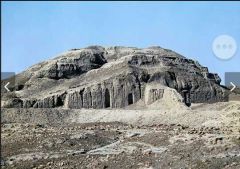
|
12. N: White Temple & it's Ziggurat D: 3500-3000 B.C.E P/S: Mesopotamia/ summerian A: Unknown OL: Urk (modern Iraq) P: The city's tax system MT: Mud Brick F: Domain of the God, used for rituals D/T: construct modest proportion C: Religious & Economic |
|
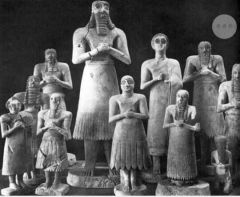
|
14. N: satues of votive figures D: 2700 BCE P/S: Mesopotamia/ summerian A: Unknown OL: Eshnunna (modern Iraq) P: The residents of Ur MT: Gypsum Stone & inlaid with she'll & black limestone F: Offering to Gods, waiting for the afterlife D/T: Inlaid, incised C: Religious |
|

|
16. N: Standard of Ur D:2600-2400 BCE P/S Mesopotamia/Summerian A: Unknown OL: Ur P: Unknown MT: inlaid with shell, lapis lazuil, & red limestone F: demonstrate peace & war D/T: Registers especially on the peace side C: Political, social |
|
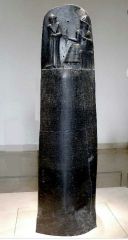
|
19. N: The code of Hammurabi D: 1792-1750 BCE P/S: Mesopotamia A: Unknown OL:Babylon P: Unknown M/T: Basalt F: A strict code of law for the people from their God D/T: Basalt C: Religious & Political
|
|
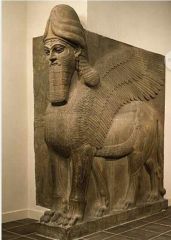
|
25. N: Lamassu from the Citadel of sargon II D: 720-705 BCE P/S: Mesopotamia/ Neo-Assyria A: Unknown OL: Dur Sharrukin P: City taxes MT: Colossal limestone F: To warn off enemies D/T: Low & high relief C: Political |
|
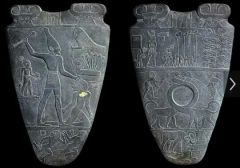
|
13. N: Palette of King Narmer D: 3000-2920 BCE P/S: Predynastic Egyptian A: Unknown OL: Egypt P: Narmer MT: Greywacke F: Also used to prepare eye make up D/T: Demonstrates the heircial scale C: Historical; the unification of Egypt |
|

|
15. N: Seated scribe D: 4th Dynasty 2620-2500 BCE P/S: Old Kingdom Egyptian A: Unknown OL: Egypt P: Unknown MT: Painted limestone F: For the interior of the tomb DT: Copper/ arsenic inlay for the eyes & wood for the nipples C: Egyptian realism |
|
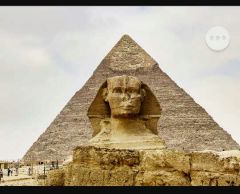
|
17. N: Great Pyramids & Great Ssphinx D: 4th Dynasty 2550-2400 BCE P/S: Old Kingdom Egyptian A: Unknown OL: Egypt P: Khafre MT: Cut limestone F: The pharohs tomb, the sphinx is a combination of han intelligence & the strength & authority of the the kings of beasts DT: Set in a necropolis C: Associated with the sun God |
|
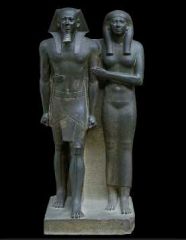
|
18. N: King Menkaura & Queen D: 4th Dynasty 2490-2472 BCE P/S: Old Kingdom Egyptian A: Unknown OL: Egypt P: Menkaure MT: Greywacke F: Indicates their marital status D/T: An emotionless embrace, his fingers are clenched her hands are gently on him C: Social/ Political |
|
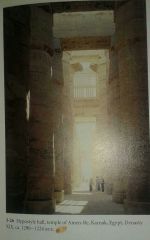
|
20. N: Temple of Amun-Re & Hypostyle Hall D: 18th & 19th Dynasties; Temple: 1550 BCE; Hall: 1250 BCE P/S: New Kingdom Egyptian A: Unknown OL: Egypt P: Unknown MT: Cut Sandstone & mud brick F: To glorify Egyptian rulers D/T: The rows of columns in Amen-Re created a clerestory, karnak- had a sunken relief culture C: Rituals |
|
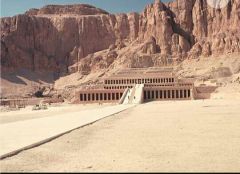
|
21. N: Mortuary Temple of Hatshepsut D: 18th Dynasty 1473-1458 BCE P/S: New Kingdom Egyptian A: Unknown OL: Egypt P: Hatshepsut MT: Sandstone, partially carved into a rock cliff, and red granite F: To worship Hatshepsut's patrón God & served as a temple in honor of Hatshepsut D/T: Colonnades; rows of columns, Pillars, squared edges C: Religious/Political |
|
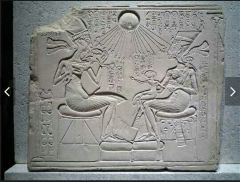
|
22. N: Akhenaton, Nefertiti, & 3 daughters D: 18th Dynasty 1353-1335 BCE P/S: New Kingdom Egyptian A: Unknown OL: Egypt P: Akhenaton MT: Limestone F: Monotheism, demonstrates the new art & religion DT: The daughters are stylized C: Religious & Art style |
|

|
23. N: Tutankhamun's Tomb, inermost coffin D: 18th Dynasty. c. 1323 BCE P/S: New Kingdom, Egyptian A: Unknown OL: Egypt P: Tutankhamun MT: Gold with inlay of enamel & emiprecious stones F: To preserve the mummy; Tutankhamun's body, demonstrates Egyptian power & pride D/T: Inlaid of stones C: Social/Political |
|
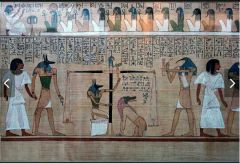
|
24. N: Last Judgement of Hu-Nefer D: 19th Dynasty. C. 1275 BCE P/S: New Kingdom, Egyptian A: Unknown OL: Egypt P: Hu-Nefer MT: Painted papyrus scroll F: The process to go into the afterlife D/T: Written in hyglrolyphics C: Religious; afterlife |
|
|
26 |
N: Athenian Agora D: 600 BCE - 150 CE P/S: Archaic through Hellenistic A: Unknown OL: Greece P: Greek government/ citizens MT: Plan F: The heart of the Athenian democracy DT: C: Political & Religious
|
|
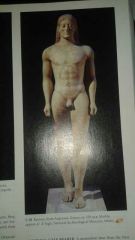
|
27. N: Anavysos Kouros D: 530 BCE P/S: Archaic Greek A: Unknown OL: Greece P: N/A MT: Marble with remnants of paint F: Votive offering, grave marker DT: Sculpture in the round, rigid stand C: Religious |
|

|
28. N: Peplos Kore from the Acropolis D: 530 BCE P/S: Archaic Greek A: Unknown OL: Greece P: N/A MT: Marble, painted details F: Offering DT: long belted woolen garment, Archaic smile & hair C: Religious |
|
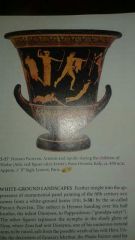
|
33. N: Niobides Krater D: 460-450 BCE P/S: Classical Greece A: Niobide Painter OL: Greece P: N/A MT: Clay, red figure technique with white highlights F: mix wine & water DT: Red Figure style, silhouette background C: Apollo & Artemis slaying the 14 children of Niome |
|
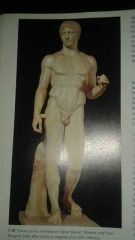
|
34. N: Doryphoros (spear bearer) D: 450-440 BCE P/S: Greek, Polykleitos style A: Polykleitos OL: Greece P: N/A MT: bronze F: the "ideal" human body DT: Chiastic a cross blance to get a perfect look, rigid stand C: The culmination of the evolution in Greek statury from the Archaic Kouros to the Kritios Boy to the riace warrior |
|
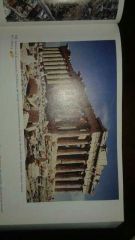
|
35. N: Acropolis D: 447-410 BCE P/S: Greek A: Iktinos & Kallikrates OL: Greece P: Greek government MT: Marble F: To house the gods DT: Large columns, sculpture C: Religious & Political |
|
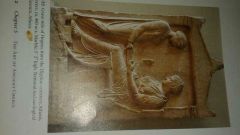
|
36. N: Grave Stele of Hegeso D: 410 BCE P/S: Greek A: Kallimachos OL: Greece P: N/A MT: Marble & paint F: To honor the dead DT: Grave Stel, high & low relief C: A young woman in her home attended by her maid |
|
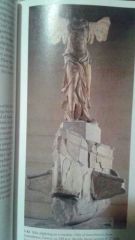
|
37. N: Winged Victory of Samothrace D: 190 BCE P/S: Hellenistic Greek A: Unknown OL: Greece P: N/A MT: Marble F: To honor Nike & the naval victory DT: Sculpture that is ideally proportioned C: Religious & Political |
|
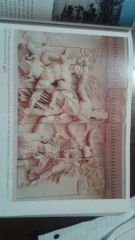
|
38. N: Great Altar of Zeus & Athena at Pergamon D: 175 BCE P/S: Hellenistic Greek A: Unknown OL: Greece P: N/A MT: Marble; Architecture & Sculpture F: Worship DT: Extremely large & deep C: The battle of the gods & the Giants |
|
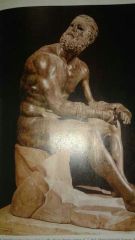
|
41. N: Seated Boxer D: 100 BCE P/S: Hellenistic Greek A: Unknown OL: Greece P: Unknown MT: Bronze F: To demonstrate Greek athletes in a non perfect way DT: Inlaid copped blood drips C: demonstrating the contrast of the ideal human body
|
|
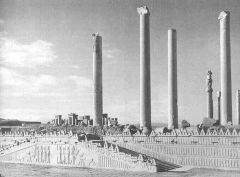
|
30 N: Audience Hall D: 520-465 B.C.E P/S: Persian/ A: Unknown OL: Iran P: King Darius M/T: Limestone F: Where king Darius receives visitors DT: High relief low relief C: Built during the Persian empire |
|
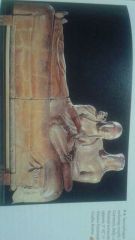
|
29. N: Saracopohagus of the spouses D: 520 B.C.E P/S: Etruscan A: Unknown OL: Italy P: Unknown MT: Terra Cotta F: To hold the remains after cremation DT: Grave marker C: A husband & wife on same banqueting couch
|
|

|
31. N: Temple of Minerva D: 510-500 B.C.E P/S: Etruscan A: Unknown OL: Rome P: Unknown MT: Mud Brick, terra cotta sculpture F: To honor the Roman gods DT: 3 cellas, portico, 2 collonade C: The 3 cellas were for Minerva, Jupiter, & Juno |
|

|
32. N: Tomb of Triclinium D: 480-470 B.C.E P/S: Etruscan A: Unknown OL: Italy P: None MT:Tufa & fresco F: The tomb of Triclinium; house for the dead DT: Subterranean, made of tufa C: Their belief system for the afterlife is similar to the Egyptian's in which they want to take all their belongings |
|
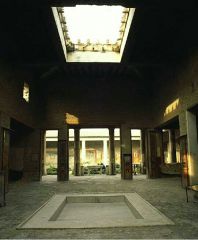
|
N: House of the Vettii D: 62-79 C.E P/S: Imperial Roman A: Unknown OL: Italy P: None MT: Cut stone & fresco F: Atrium/ town house DT: vestibule; entrance, impluvim; collect water C: A Roman town house mainly for the wealthy & patricians |
|
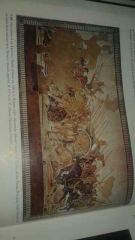
|
40. N: Alexander Mosaic from the House of Faun D: 100 B.C.E P/S: Republican Roman A: Unknown OL: Rome P: citizens of Pompeii MT: Mosaic F: Decorate DT: monumental painting, rearing horses in 3 quarter rear view C: The battle of Alexander the great against the Persian king Darius |
|
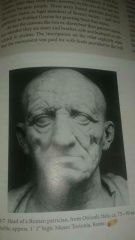
|
42. N: Head of a Roman Patrician D: 75-50 B.C.E. P/S: Republican Roman A: Unknown OL: Rome P: Roman Patrician MT: Marble F: Bust of an important citizen DT: veristic portrait, bust sculpture C: It demonstrated how wise & knowledgeable they were
|
|
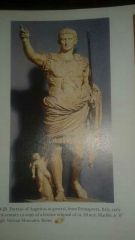
|
43. N: Augustus of Prima Porta D: Early 1st Century P/S: Early empire A: Unknown OL: Rome P: Tiberius Ceasar MT: Marble F: Commemorate monument DT: Political C: Important diplomatic victory, cupid proclaims his divine dissent |
|
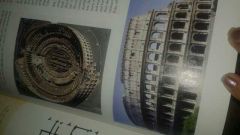
|
44. N: Colosseum D: 70-80 C.E. P/S: Imperial Roman A: Unknown OL: Rome P: Vespasian MT: Stone & Concrete F: Entertainment; animal fights & gladiator battles DT: Greek arches, doric, ionic & corrinthenian columns C: Identifies Rome, can hold.more than 50,000 spectators |
|
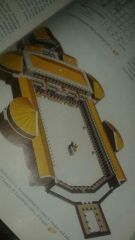
|
45. N: Forum of Tarjan D: 106-112 C.E. P/S: A: Apollodorus of Damascus OL: Rome P: Tarjan MT: Brick & Concrete; Marble F: glorified Tarjans victories DT: Colonnades, giant commemorative column C: Built after the 2 victories against Dacian |
|

|
46. N: Pantheon D: 118-125 B.C.E. P/S: Imperial Roman A: Unknown OL: Rome P: Unknown MT: Concrete with stone facing F: the temple of all gods DT: Corinthian columns, oculus C: Best preserved building, most influential designs in architecture history |
|
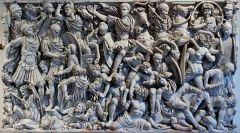
|
47. N: Ludovisi Battle Saracopohagus D: 250 C.E P/S: Late Imperial Roman A: Unknown OL: Rome P: Unknown MT: Marble F: Tomb DT: Relief sculpture, C: Memorial to the wars between Ostrogoths & Imperial Romans then taking place |

